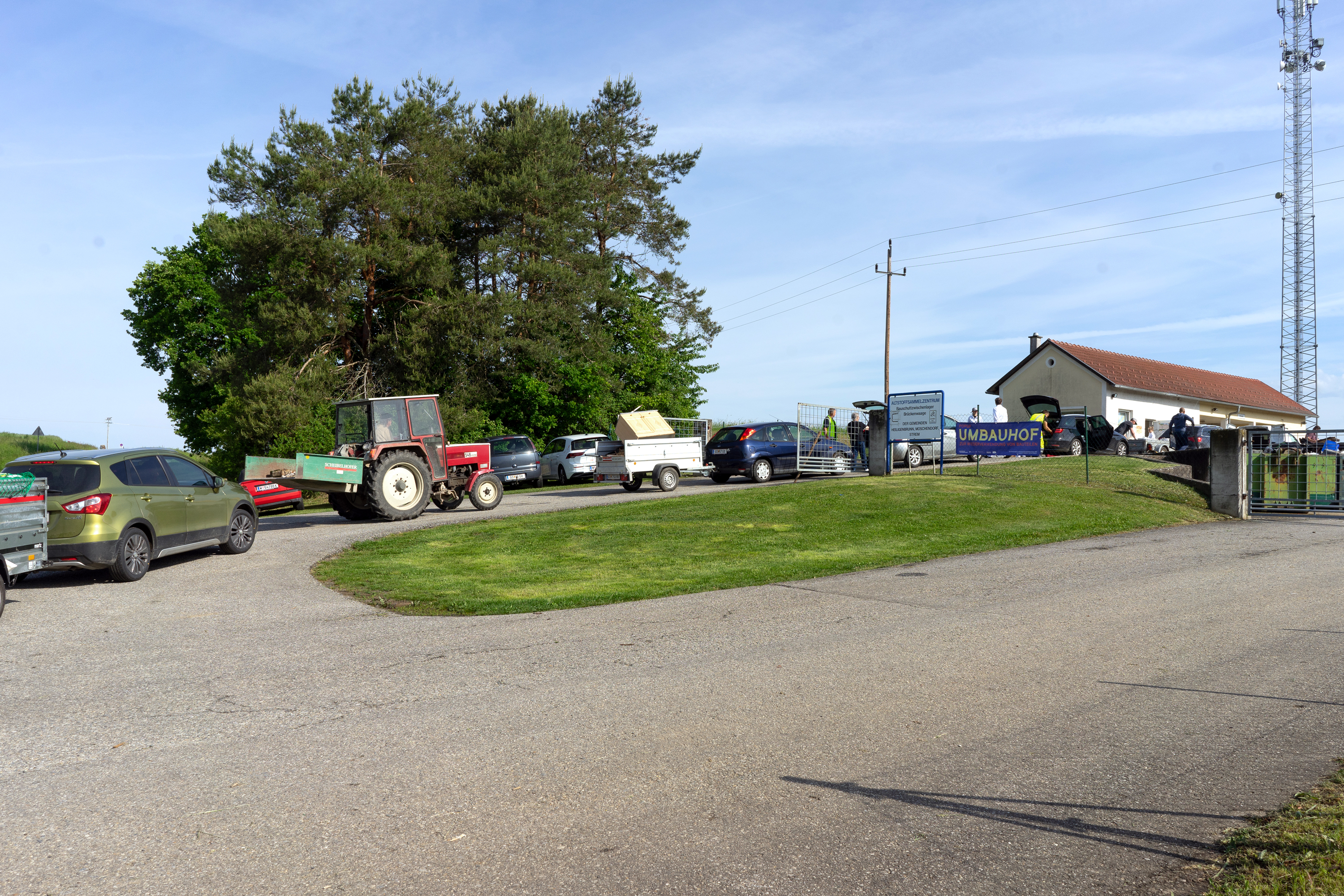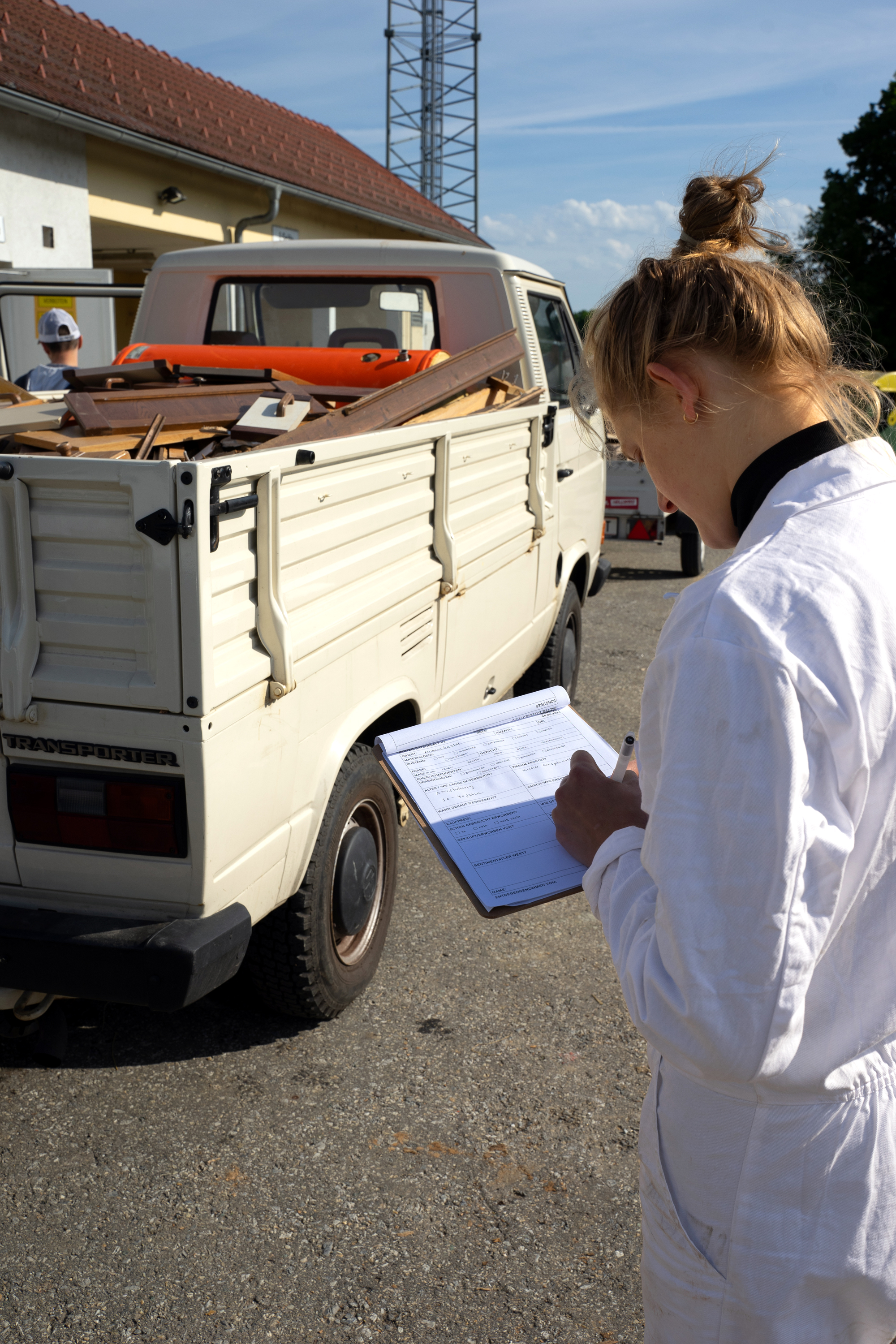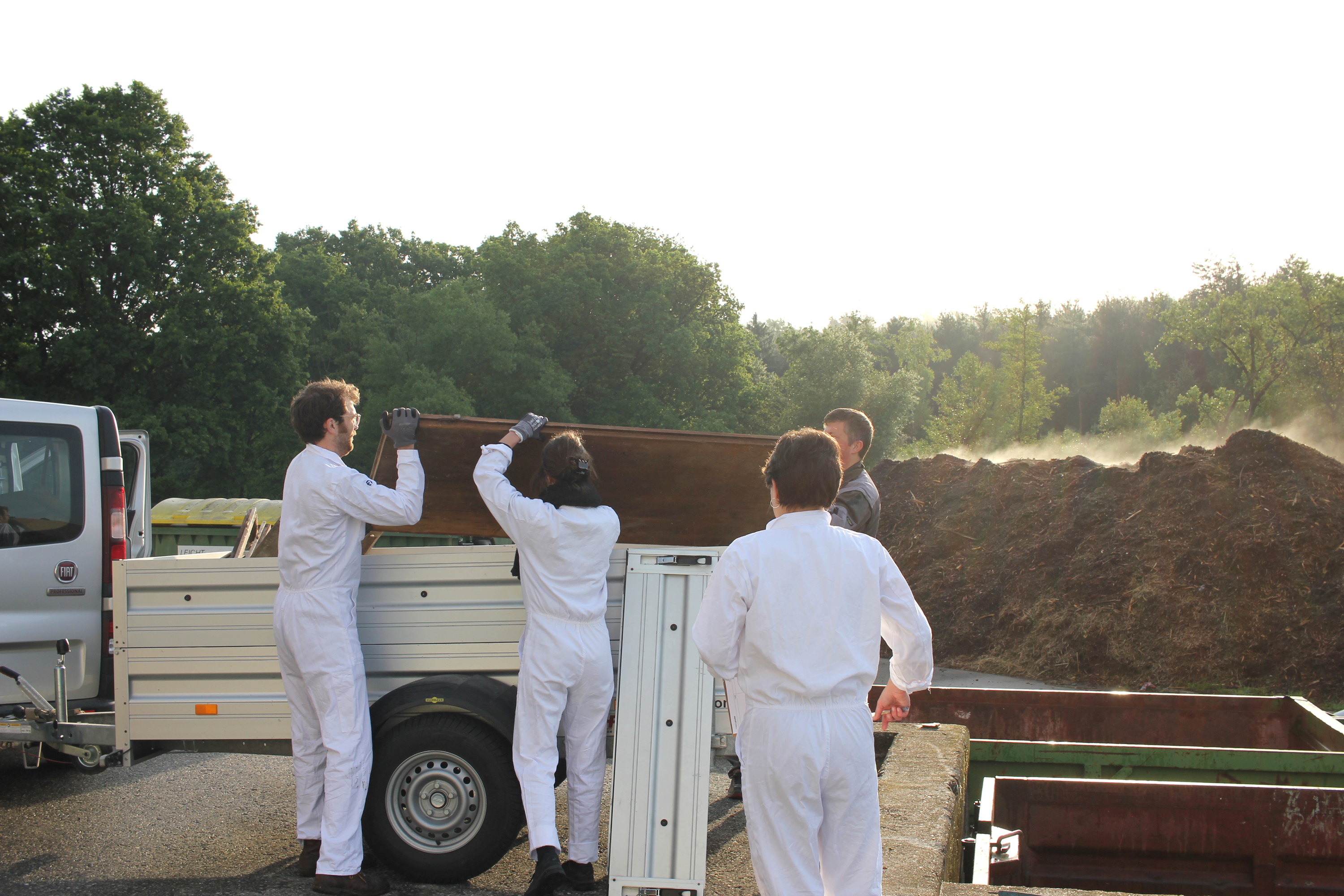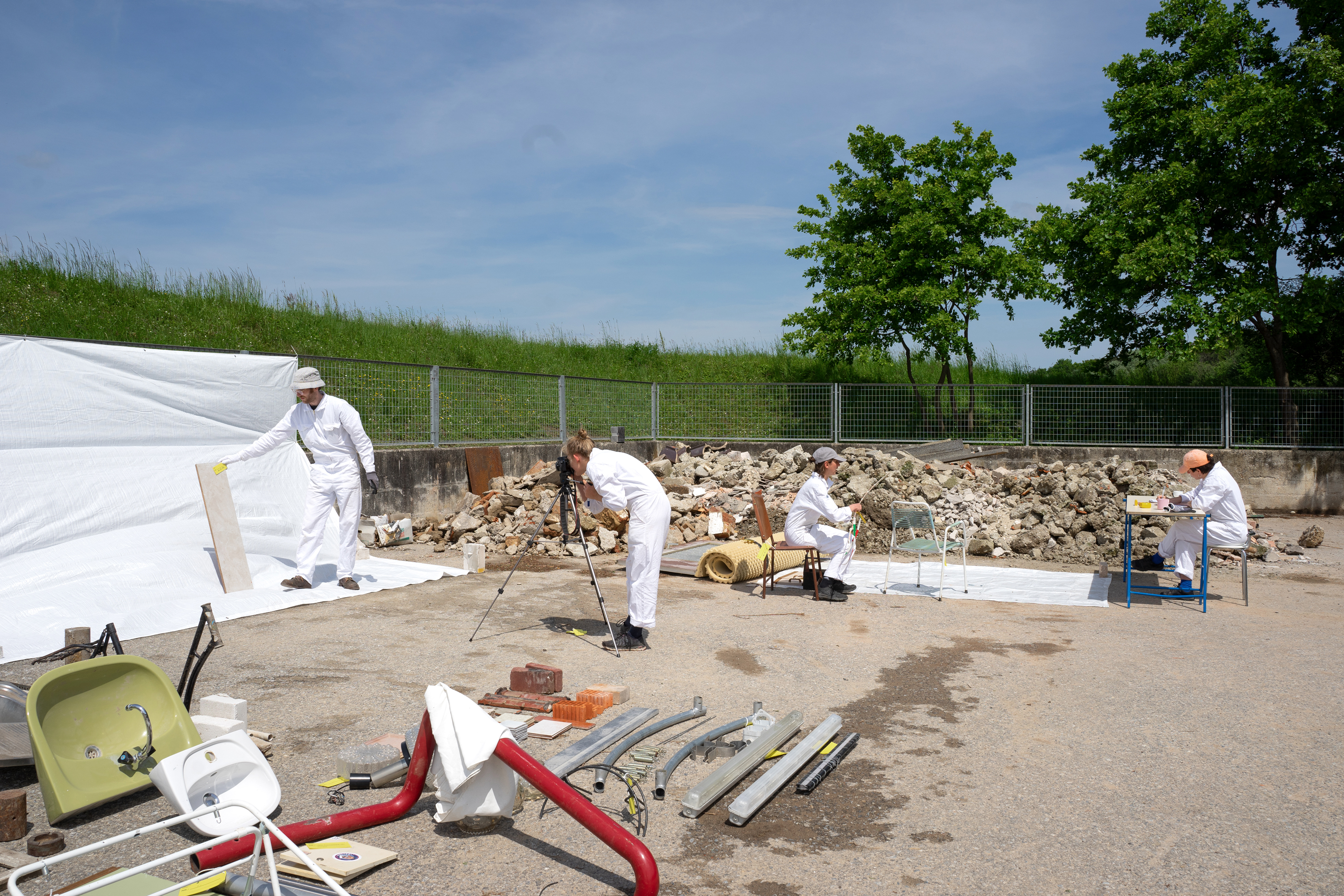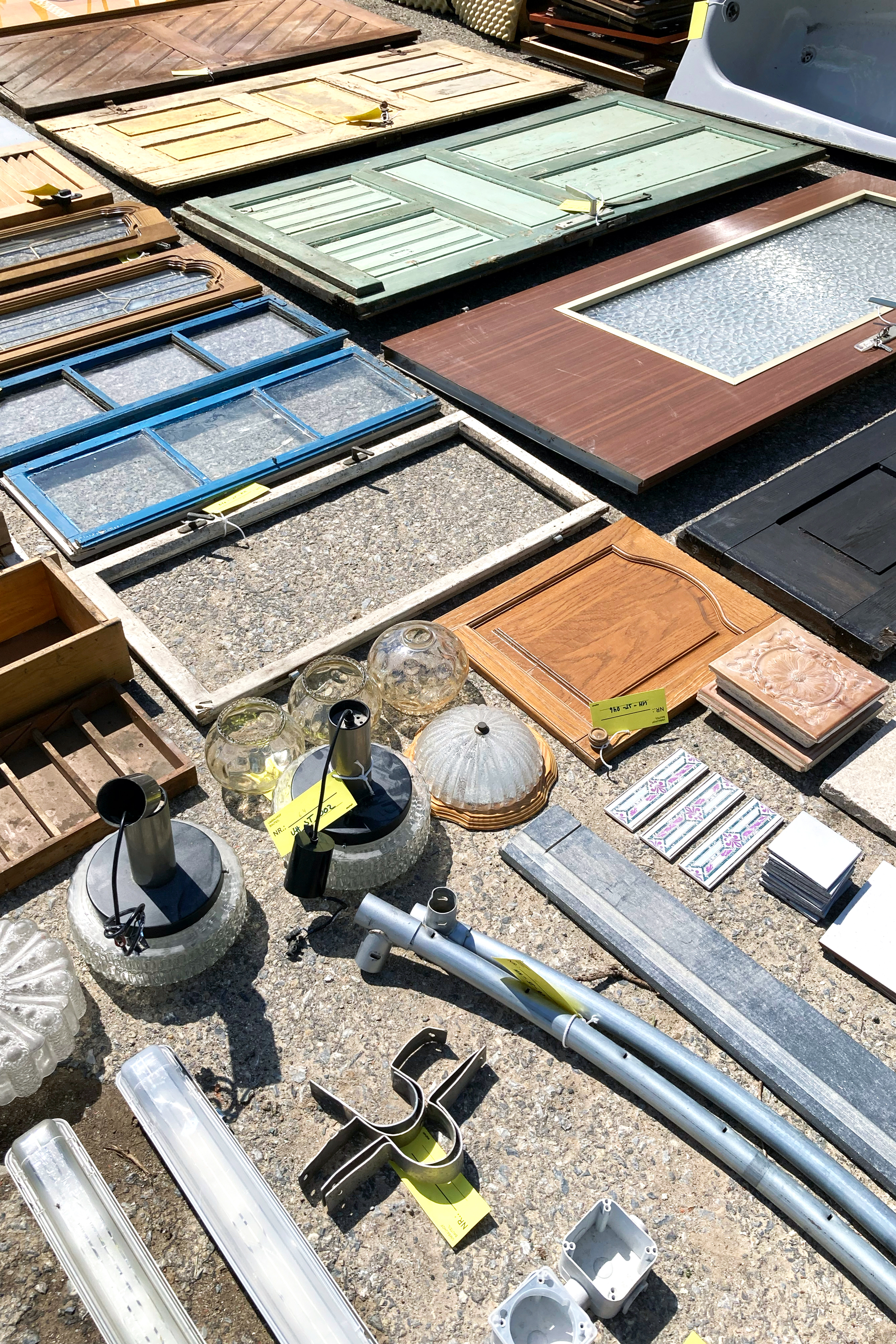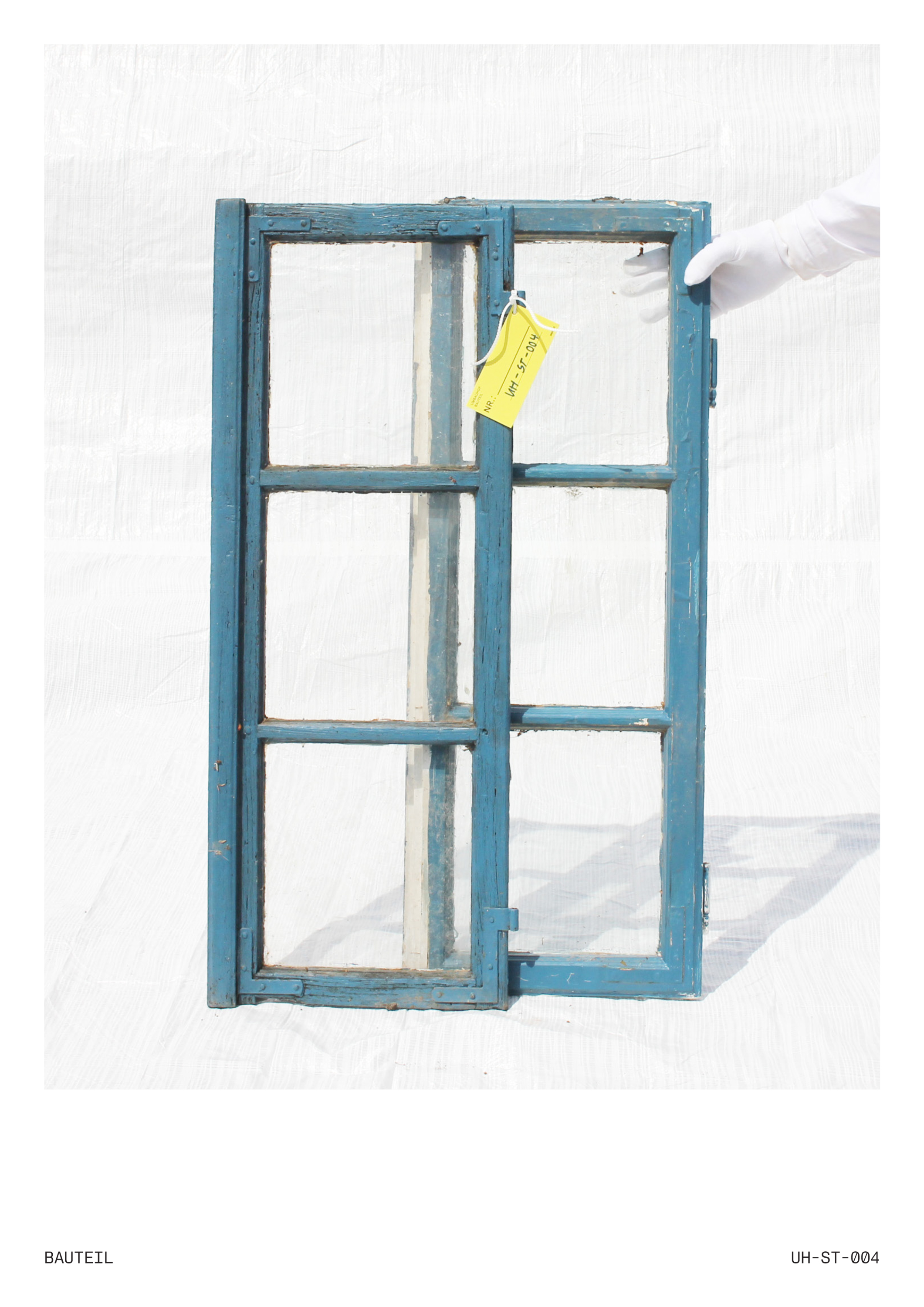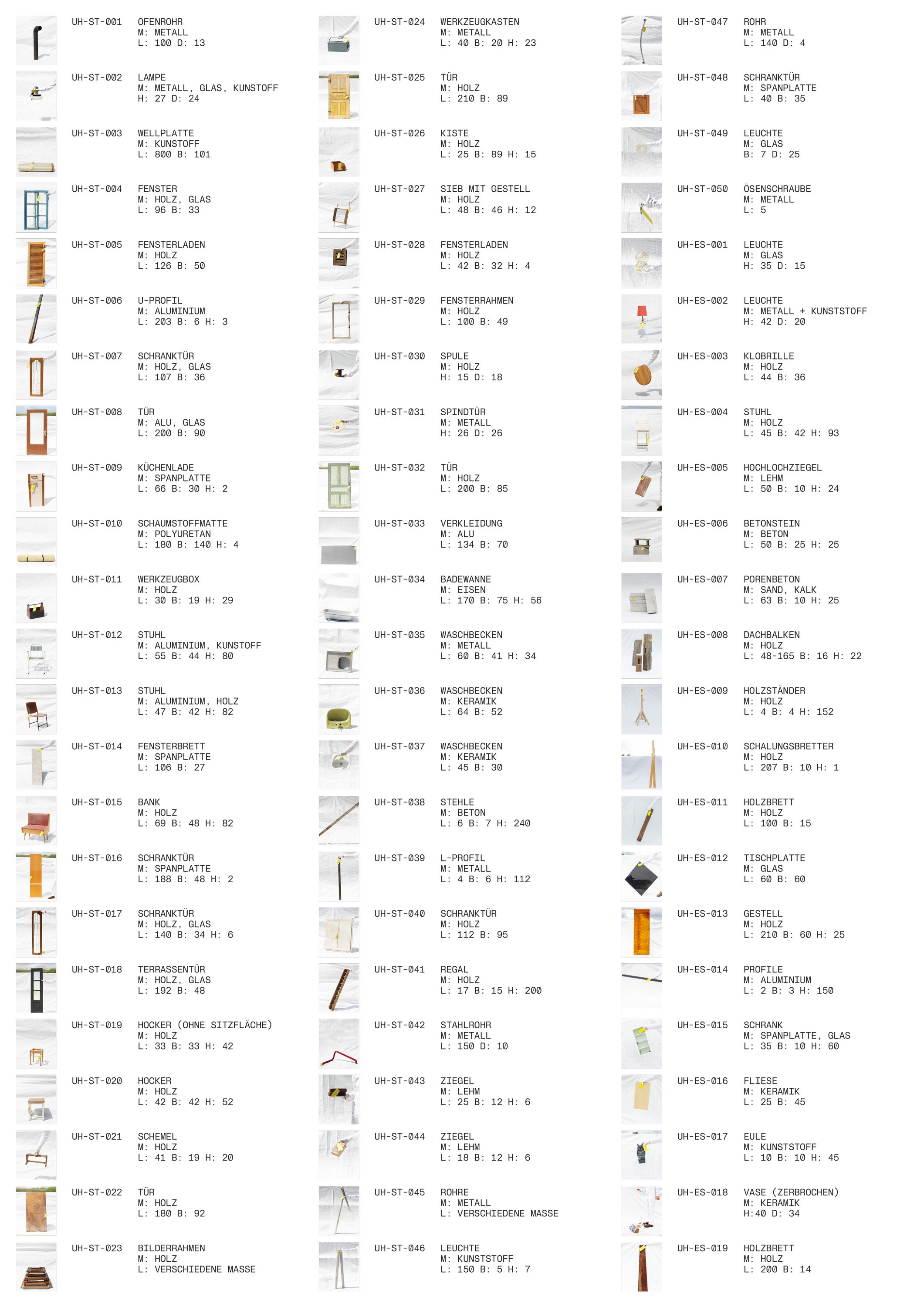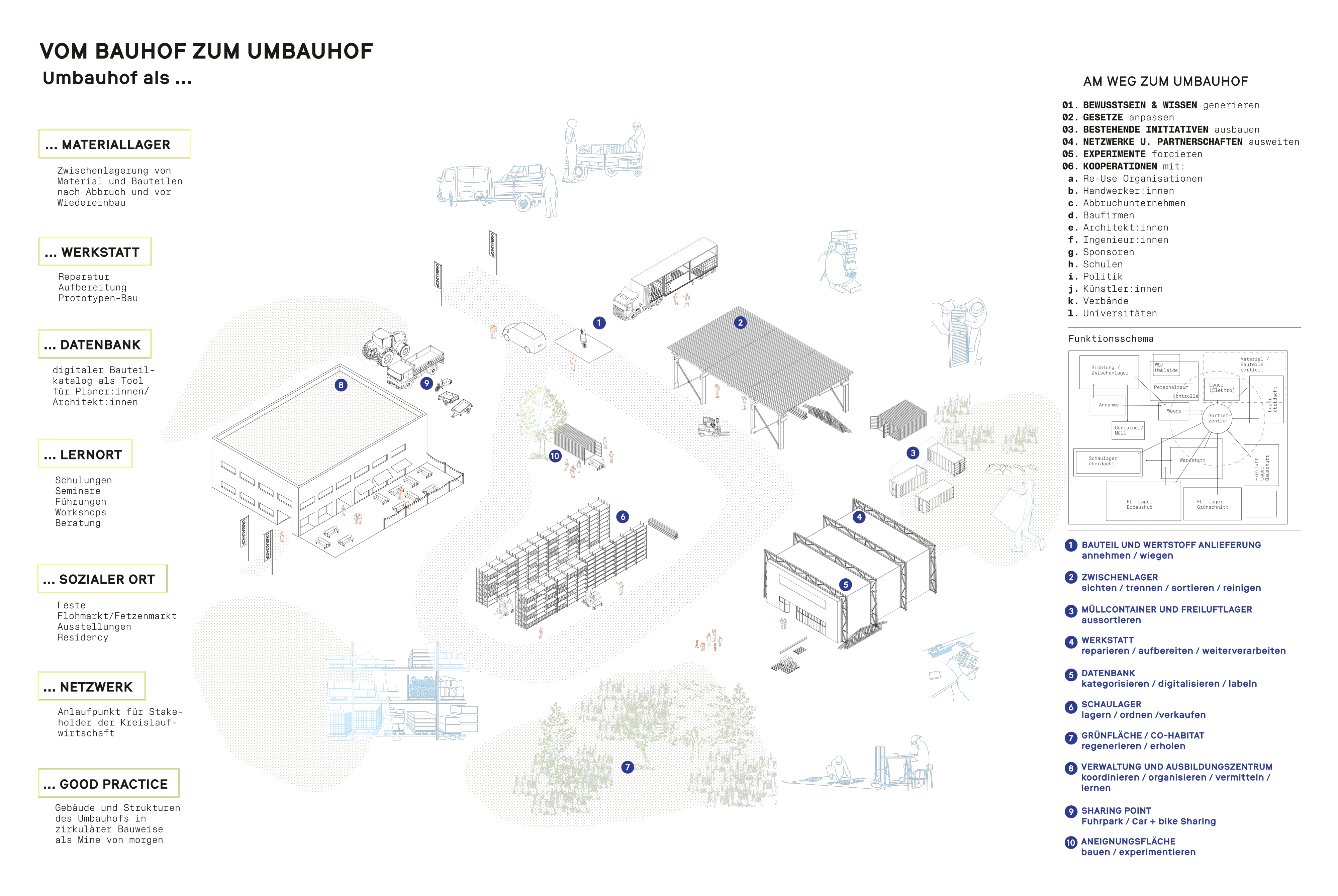Shaping a circular industrial ecosystem and supporting life-cycle thinking
UMBAUHOF: Rebuild and Reuse Yard
Acting between rebuild yard and waste collection point: The Umbauhof Approach
The Umbauhof (Rebuild and Reuse Yard) transforms municipal recycling sites into hubs for salvaged building materials, promoting reuse, sustainability, and circular construction. Through pop-up interventions, it engages communities, sparks dialogue, and showcases the potential of reclaimed materials. Looking ahead, the vision is to establish permanent Umbauhöfe – learning centers and marketplaces for circular building – redefining rural construction practices.
Austria
Regional
Burgenland
Mainly rural
It refers to other types of transformations (soft investment)
Yes
2024-07-21
No
No
No
As a representative of an organisation, in partnership with other organisations
The UMBAUHOF (Rebuild and Reuse Yard) redefines waste as a valuable resource by transforming municipal infrastructures into circular economy hubs. It promotes the reuse of building materials to minimize waste, reduce carbon emissions, and foster sustainable building practices in rural areas. As part of this effort, conventional Bauhöfe (municipal construction yards) and waste collection sites were temporarily transformed into pop-up Umbauhöfe (Rebuild and Reuse Yard). These interventions provided spaces for systematically collecting, sorting, documenting, repairing, and redistributing salvaged materials.
A key element of the project was its performative approach – engaging local authorities and the community in dialogue. The pop-ups acted as catalysts for discussions, challenged perceptions of waste, and encouraged a reassessment of existing materials and their potential applications.
Beyond the temporary interventions, the Umbauhof project initiated discussions about establishing a permanent municipal infrastructure dedicated to material reuse. This vision proposes the permanent transformation of municipal waste collection sites into Umbauhöfe – dedicated hubs for salvaged building materials and a learning center for circular construction – supporting a circular economy within the built environment.
A key element of the project was its performative approach – engaging local authorities and the community in dialogue. The pop-ups acted as catalysts for discussions, challenged perceptions of waste, and encouraged a reassessment of existing materials and their potential applications.
Beyond the temporary interventions, the Umbauhof project initiated discussions about establishing a permanent municipal infrastructure dedicated to material reuse. This vision proposes the permanent transformation of municipal waste collection sites into Umbauhöfe – dedicated hubs for salvaged building materials and a learning center for circular construction – supporting a circular economy within the built environment.
Institutional circular Economy
Waste transformation for sustainable construction
Community engagement
Rural innovation
Transferability and Scalability
The Umbauhof challenges unsustainable standards in waste management and construction by uncovering the untapped potential of material circularity. The pop-up interventions have already achieved tangible results: they facilitated direct contact with residents, sparked discussions on material reuse, and highlighted the potential of salvaged building materials. Through these temporary spaces, materials were collected, sorted, and documented, making material flows more visible and accessible. These interactions helped shift perspectives on what is considered waste and showcased reuse as a viable alternative to disposal.
Building upon these initial successes, the long-term Umbauhof vision proposes the transformation of municipal waste collection sites into dedicated circular hubs. These permanent Umbauhöfe will function as both material recovery centers and learning spaces for sustainable construction and economic practices. They will provide a marketplace for salvaged building materials, ensuring that high-quality components remain in circulation instead of becoming waste. Additionally, on-site upcycling workshops will be integrated, offering opportunities for processing and repurposing materials.
To further institutionalize reuse, the Umbauhof will embed circular economy principles within local governance structures. It will include a digital material catalog and real-time tracking systems to streamline material flows and enhance efficiency. Through hands-on training and public engagement, stakeholders will gain practical skills in circular building techniques, paving the way for a shift toward more responsible and resilient construction practices. This initiative aims to establish a scalable and replicable model that can inspire municipalities across Europe to integrate material reuse into their waste management and construction policies.
Building upon these initial successes, the long-term Umbauhof vision proposes the transformation of municipal waste collection sites into dedicated circular hubs. These permanent Umbauhöfe will function as both material recovery centers and learning spaces for sustainable construction and economic practices. They will provide a marketplace for salvaged building materials, ensuring that high-quality components remain in circulation instead of becoming waste. Additionally, on-site upcycling workshops will be integrated, offering opportunities for processing and repurposing materials.
To further institutionalize reuse, the Umbauhof will embed circular economy principles within local governance structures. It will include a digital material catalog and real-time tracking systems to streamline material flows and enhance efficiency. Through hands-on training and public engagement, stakeholders will gain practical skills in circular building techniques, paving the way for a shift toward more responsible and resilient construction practices. This initiative aims to establish a scalable and replicable model that can inspire municipalities across Europe to integrate material reuse into their waste management and construction policies.
During the Umbauhof pop-ups, conversations with local communities revealed a common perception that many objects are considered waste simply because they are outdated, despite being fully functional. The lack of imagination regarding how these materials could be repurposed—through reassembly, refinishing, or adaptation—was a recurring theme. This challenge extends beyond small-scale design objects, such as furniture, to larger architectural applications, including repurposing materials into structural elements, façade components, and insulation.
The long-term Umbauhof concept will address this gap by fostering a new aesthetic language for circular construction. As a permanent infrastructure, it will serve as a learning center that cultivates skills in material transformation. By providing workshops and hands-on training, it will demonstrate how outdated materials can be given a contemporary form and function. The aim is to establish a structured approach to material reuse that integrates craftsmanship with modern design methodologies, ensuring that salvaged materials are seen as valuable resources.
Instead of relying on a bricolage aesthetic, the Umbauhof will promote a deliberate design strategy that ensures coherence and quality in reused materials. Through iterative prototyping, experimentation, and cross-disciplinary collaboration, the initiative will elevate the perception of circular materials, demonstrating their potential to contribute to durable and visually compelling built environments.
Furthermore, the Umbauhof will cater to a diverse audience, providing tailored learning opportunities for architects, craftsmen, municipal workers, and the general public. This inclusive approach will strengthen local networks and encourage the acceptance of circular construction as a viable and desirable alternative. By serving as both a reuse hub and a platform for knowledge exchange, the Umbauhof will lay the foundation for a new rural building culture.
The long-term Umbauhof concept will address this gap by fostering a new aesthetic language for circular construction. As a permanent infrastructure, it will serve as a learning center that cultivates skills in material transformation. By providing workshops and hands-on training, it will demonstrate how outdated materials can be given a contemporary form and function. The aim is to establish a structured approach to material reuse that integrates craftsmanship with modern design methodologies, ensuring that salvaged materials are seen as valuable resources.
Instead of relying on a bricolage aesthetic, the Umbauhof will promote a deliberate design strategy that ensures coherence and quality in reused materials. Through iterative prototyping, experimentation, and cross-disciplinary collaboration, the initiative will elevate the perception of circular materials, demonstrating their potential to contribute to durable and visually compelling built environments.
Furthermore, the Umbauhof will cater to a diverse audience, providing tailored learning opportunities for architects, craftsmen, municipal workers, and the general public. This inclusive approach will strengthen local networks and encourage the acceptance of circular construction as a viable and desirable alternative. By serving as both a reuse hub and a platform for knowledge exchange, the Umbauhof will lay the foundation for a new rural building culture.
The Umbauhof pop-ups were designed as accessible, low-threshold events at municipal recycling centers, where people already interact with discarded materials. This direct approach allowed hands-on discussions about reusing resources, engaging residents, municipal workers, and artisans. By meeting people the pop-ups shifted perceptions around waste, laying the groundwork for viewing salvaged materials as valuable resources.
Building on these experiences, the Umbauhof envisions permanent reuse hubs acting as marketplaces and learning centers. They will offer builders, architects, and homeowners direct access to salvaged materials, along with workshops and training. Flexible pricing and donation programs will enhance affordability, while policies developed with municipalities and community groups will expand reuse practices.
Serving as both a community resource and a driver of change, the Umbauhof will help normalize circular construction – particularly in rural areas – ensuring salvaged materials become integral to future building practices.
Building on these experiences, the Umbauhof envisions permanent reuse hubs acting as marketplaces and learning centers. They will offer builders, architects, and homeowners direct access to salvaged materials, along with workshops and training. Flexible pricing and donation programs will enhance affordability, while policies developed with municipalities and community groups will expand reuse practices.
Serving as both a community resource and a driver of change, the Umbauhof will help normalize circular construction – particularly in rural areas – ensuring salvaged materials become integral to future building practices.
The Umbauhof actively involves local residents and civil society organizations through participatory workshops, material exchanges, and storytelling initiatives. These activities highlight the historical and cultural significance of salvaged materials, fostering awareness and engagement. By making material flows visible and accessible, the initiative challenges perceptions of waste and encourages creative reuse.
Oral history interviews document local narratives around materials, preserving their intangible value alongside their physical reuse. Public engagement events, including guided tours and interactive demonstrations, enhance material literacy and deepen understanding of circular construction.
Beyond awareness-building, the Umbauhof provides a platform for civic participation, allowing residents to contribute to sustainable building solutions. By involving individuals from diverse backgrounds, the initiative strengthens local networks and promotes shared responsibility for shaping the built environment. These inclusive approaches help communities transition toward a more circular and resource-conscious future.These efforts document and celebrate the historical and cultural significance of salvaged materials, reinforcing a collective understanding of reuse practices.
Oral history interviews document local narratives around materials, preserving their intangible value alongside their physical reuse. Public engagement events, including guided tours and interactive demonstrations, enhance material literacy and deepen understanding of circular construction.
Beyond awareness-building, the Umbauhof provides a platform for civic participation, allowing residents to contribute to sustainable building solutions. By involving individuals from diverse backgrounds, the initiative strengthens local networks and promotes shared responsibility for shaping the built environment. These inclusive approaches help communities transition toward a more circular and resource-conscious future.These efforts document and celebrate the historical and cultural significance of salvaged materials, reinforcing a collective understanding of reuse practices.
The initiative operates within a multi-scalar governance framework, collaborating with regional partners, waste management authorities, municipal governments, and circular economy specialists. The project was initiated by Architektur Raum Burgenland, which provided financing, developed the project idea, organized the call for proposals, and contributed through regular exchanges, workshops, and exhibitions. asphalt / Kollektiv für Architektur played a key role in conceptualization, implementation, and the execution of the Umbauhöfe, as well as documentation of the process.
The initiative benefits from expertise provided by Material Nomaden, which contributed knowledge on circular construction, reuse methodologies, and strategic planning through regular meetings. BMV – Burgenländischer Müllverband served as a key cooperation partner, sharing expertise and providing guidance on waste management integration. UDB – Umweltdienst Burgenland facilitated access to waste collection sites for the Umbauhof pop-ups, collaborated with local personnel, and enabled interventions into daily operations.
Additionally, the municipalities of Strem and Eisenstadt supported the initiative by connecting with local governments and providing expert input. These local institutions ensures the project’s integration into regional policy discussions, bridging grassroots initiatives with institutional urban planning strategies. The Umbauhof aligns with broader European sustainability agendas, positioning itself as a viable model for policy-driven ecological transition.
The initiative benefits from expertise provided by Material Nomaden, which contributed knowledge on circular construction, reuse methodologies, and strategic planning through regular meetings. BMV – Burgenländischer Müllverband served as a key cooperation partner, sharing expertise and providing guidance on waste management integration. UDB – Umweltdienst Burgenland facilitated access to waste collection sites for the Umbauhof pop-ups, collaborated with local personnel, and enabled interventions into daily operations.
Additionally, the municipalities of Strem and Eisenstadt supported the initiative by connecting with local governments and providing expert input. These local institutions ensures the project’s integration into regional policy discussions, bridging grassroots initiatives with institutional urban planning strategies. The Umbauhof aligns with broader European sustainability agendas, positioning itself as a viable model for policy-driven ecological transition.
The Umbauhof builds upon an extensive transdisciplinary network, integrating expertise from architecture, urban planning, waste management, and environmental policy. A comprehensive research phase preceded the project, including best-practice case studies and a mapping of European circular design initiatives and material exchanges. These insights informed the project's methodology, ensuring a well-rounded and adaptable model.
The planning process involved regular exchanges, workshops, and consultations, emphasizing cross-sectoral learning, to refine strategies for material reuse and circular economy principles. Strong ties to municipal administrations and waste management institutions ensured that the Umbauhof's approach was both innovative and practical. The initiative also benefited from partnerships with the municipalities of Strem and Eisenstadt, whose engagement provided valuable regional insights and strengthened the connection to local governance structures.
An essential part of the project was the intensive exchange with the local population during the pop-up interventions. These interactions created an open dialogue on circularity, material consciousness, and sustainable construction. Residents were actively involved in discussions, contributing perspectives on waste, reuse possibilities, and the potential of integrating these principles into everyday building practices. These exchanges helped challenge existing perceptions and identify opportunities for future reuse strategies.
Through these interdisciplinary collaborations and participatory discussions, the Umbauhof advances circular construction while fostering a broader cultural shift in material consciousness, bridging the gap between policy frameworks, technical expertise, and community-driven action.
The planning process involved regular exchanges, workshops, and consultations, emphasizing cross-sectoral learning, to refine strategies for material reuse and circular economy principles. Strong ties to municipal administrations and waste management institutions ensured that the Umbauhof's approach was both innovative and practical. The initiative also benefited from partnerships with the municipalities of Strem and Eisenstadt, whose engagement provided valuable regional insights and strengthened the connection to local governance structures.
An essential part of the project was the intensive exchange with the local population during the pop-up interventions. These interactions created an open dialogue on circularity, material consciousness, and sustainable construction. Residents were actively involved in discussions, contributing perspectives on waste, reuse possibilities, and the potential of integrating these principles into everyday building practices. These exchanges helped challenge existing perceptions and identify opportunities for future reuse strategies.
Through these interdisciplinary collaborations and participatory discussions, the Umbauhof advances circular construction while fostering a broader cultural shift in material consciousness, bridging the gap between policy frameworks, technical expertise, and community-driven action.
The Umbauhof challenges conventional waste management and construction practices by embedding circularity at the core of its approach. Instead of treating demolition waste as an inevitable byproduct, the initiative envisions structures as temporary material repositories, extending the lifecycle of building components. This shift moves beyond simple material recovery toward systemic transformation.
A key innovation is the integration of pop-up interventions, which serve as both experimental spaces and engagement platforms. These temporary sites actively demonstrate material reuse in real-world conditions, engaging local communities and decision-makers in discussions about the feasibility of circular construction.
Additionally, the initiative is complemented by a long-term concept that envisions the establishment of a Umbauhof as a novel municipal infrastructure. This framework aims to integrate circular economy principles into public waste management systems, transforming traditional disposal sites into active reuse and material exchange hubs. By institutionalizing circular construction, the Umbauhof seeks to create a lasting impact on local building practices, promoting resource efficiency and systemic change.
A key innovation is the integration of pop-up interventions, which serve as both experimental spaces and engagement platforms. These temporary sites actively demonstrate material reuse in real-world conditions, engaging local communities and decision-makers in discussions about the feasibility of circular construction.
Additionally, the initiative is complemented by a long-term concept that envisions the establishment of a Umbauhof as a novel municipal infrastructure. This framework aims to integrate circular economy principles into public waste management systems, transforming traditional disposal sites into active reuse and material exchange hubs. By institutionalizing circular construction, the Umbauhof seeks to create a lasting impact on local building practices, promoting resource efficiency and systemic change.
Research and Analysis
- Mapping of regional waste flows, best practices, and European circular design initiatives
- Identification of reuse opportunities and material exchange networks
Implementation
- Pop-up Umbauhöfe: Temporary spaces for testing, material collection, processing, and redistribution
- Oral History: Collection of local knowledge and narratives on material use and construction traditions through interviews and community engagement. These insights helped to contextualize reuse practices and highlight cultural aspects of circular building.
- Material Documentation: Collection, measurement, cleaning, and classification of reclaimed materials. A detailed building component catalog was created to document reusable elements, facilitating efficient redistribution and integration into new construction projects.
- Workshops & Public Engagement: Interactive events and the creation of social "third spaces" to encourage communal participation and the exchange of knowledge.
Policy and Future Development
- Integration of findings into municipal frameworks
- Development of a long-term strategy for a permanent Umbauhof as municipal infrastructure
- Policy recommendations to institutionalize material reuse in local governance
- Mapping of regional waste flows, best practices, and European circular design initiatives
- Identification of reuse opportunities and material exchange networks
Implementation
- Pop-up Umbauhöfe: Temporary spaces for testing, material collection, processing, and redistribution
- Oral History: Collection of local knowledge and narratives on material use and construction traditions through interviews and community engagement. These insights helped to contextualize reuse practices and highlight cultural aspects of circular building.
- Material Documentation: Collection, measurement, cleaning, and classification of reclaimed materials. A detailed building component catalog was created to document reusable elements, facilitating efficient redistribution and integration into new construction projects.
- Workshops & Public Engagement: Interactive events and the creation of social "third spaces" to encourage communal participation and the exchange of knowledge.
Policy and Future Development
- Integration of findings into municipal frameworks
- Development of a long-term strategy for a permanent Umbauhof as municipal infrastructure
- Policy recommendations to institutionalize material reuse in local governance
The Umbauhof concept is highly transferable and adaptable to various regional contexts. Several elements make it an effective model for replication. The Pop-up Umbauhof provides a low-cost, flexible intervention that can be implemented in different municipalities to engage communities in circular building practices. The material documentation creates a structured approach to rescue, cataloging, and redistributing materials, ensuring transparency and efficiency in reuse processes. Additionally, the project’s policy framework offers a model for integrating circular economy strategies into municipal waste management policies.
The educational component in the concept, in the form of a learning center, can be adapted to different regions, encouraging knowledge exchange and promoting a deeper appreciation for craftsmanship and sustainable construction methods. By sharing best practices and open-access resources, the Umbauhof provides a replicable blueprint for other municipalities seeking to transition toward circular material flows and sustainable urban development. The Umbauhof concept is designed to be scalable and adaptable across different regions.
The educational component in the concept, in the form of a learning center, can be adapted to different regions, encouraging knowledge exchange and promoting a deeper appreciation for craftsmanship and sustainable construction methods. By sharing best practices and open-access resources, the Umbauhof provides a replicable blueprint for other municipalities seeking to transition toward circular material flows and sustainable urban development. The Umbauhof concept is designed to be scalable and adaptable across different regions.
The Umbauhof pop-up interventions provided a direct response to global environmental and social challenges by demonstrating material reuse on a local scale. Through these temporary interventions, the project showcased how salvaged construction materials can be reintegrated into the building process, significantly reducing landfill waste and lowering CO2 emissions associated with material production and disposal.
Looking ahead, the Umbauhof concept will further develop into a permanent municipal infrastructure, institutionalizing circular material flows. This future transformation aims to mitigate climate change by embedding reuse within standard construction practices, addressing resource scarcity through the structured redistribution of materials, and strengthening community resilience by creating hubs for social engagement and local economic development.
By actively involving residents, municipal workers, and artisans, the pop-ups initiated dialogue around circular economy principles, fostering a collective sense of responsibility for material use. In the long term, the Umbauhof will serve as a permanent platform bridging grassroots action with municipal policy efforts, creating a scalable model for sustainable urban development and circular construction practices. One of its core contributions is climate change mitigation through the reduction of construction waste and material reuse, which significantly lowers CO2 emissions associated with material production and disposal. By promoting a shift away from linear building practices, the project contributes to reducing resource scarcity by maximizing the value of existing materials.
Looking ahead, the Umbauhof concept will further develop into a permanent municipal infrastructure, institutionalizing circular material flows. This future transformation aims to mitigate climate change by embedding reuse within standard construction practices, addressing resource scarcity through the structured redistribution of materials, and strengthening community resilience by creating hubs for social engagement and local economic development.
By actively involving residents, municipal workers, and artisans, the pop-ups initiated dialogue around circular economy principles, fostering a collective sense of responsibility for material use. In the long term, the Umbauhof will serve as a permanent platform bridging grassroots action with municipal policy efforts, creating a scalable model for sustainable urban development and circular construction practices. One of its core contributions is climate change mitigation through the reduction of construction waste and material reuse, which significantly lowers CO2 emissions associated with material production and disposal. By promoting a shift away from linear building practices, the project contributes to reducing resource scarcity by maximizing the value of existing materials.
Through the pop-up Umbauhof, the project actively raised awareness about circular material reuse and initiated a public discourse on sustainable construction. The interventions facilitated direct engagement with local communities and municipal stakeholders, making material flows visible and demonstrating the practical feasibility of reusing construction materials, engaging within "invisible infrastructures", creating direct relations with the space and the workers - becoming part of the existing network.
The outcomes of the pop-up interventions were documented and exhibited at Architektur Raumburgenland from June 7 to July 21, 2024, providing a platform for further discussions on the integration of circular economy principles into local policies.
Looking ahead, the future Umbauhof concept will aim to achieve:
- Environmental Impact: The long-term reduction of landfill waste through the establishment of permanent reuse infrastructure, significantly lowering emissions linked to material disposal and new material production.
- Economic Benefits: The development of a structured marketplace for salvaged materials, reducing costs for municipalities, builders, and homeowners while fostering local material economies.
- Educational and Social Engagement: The creation of a learning center within the future Umbauhof to provide knowledge on circular construction, traditional craftsmanship, and innovative reuse methods.
- Policy Influence: The institutionalization of circular building practices within local government frameworks, promoting regulatory support for reuse initiatives and integrating them into urban and rural development strategies.
By building on the results of the pop-up phase, the Umbauhof aims to establish itself as a permanent infrastructure, demonstrating how circular economy principles can be systematically embedded into regional construction and waste management systems.
The outcomes of the pop-up interventions were documented and exhibited at Architektur Raumburgenland from June 7 to July 21, 2024, providing a platform for further discussions on the integration of circular economy principles into local policies.
Looking ahead, the future Umbauhof concept will aim to achieve:
- Environmental Impact: The long-term reduction of landfill waste through the establishment of permanent reuse infrastructure, significantly lowering emissions linked to material disposal and new material production.
- Economic Benefits: The development of a structured marketplace for salvaged materials, reducing costs for municipalities, builders, and homeowners while fostering local material economies.
- Educational and Social Engagement: The creation of a learning center within the future Umbauhof to provide knowledge on circular construction, traditional craftsmanship, and innovative reuse methods.
- Policy Influence: The institutionalization of circular building practices within local government frameworks, promoting regulatory support for reuse initiatives and integrating them into urban and rural development strategies.
By building on the results of the pop-up phase, the Umbauhof aims to establish itself as a permanent infrastructure, demonstrating how circular economy principles can be systematically embedded into regional construction and waste management systems.

